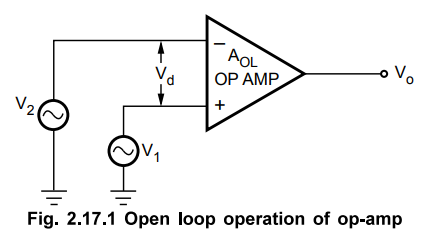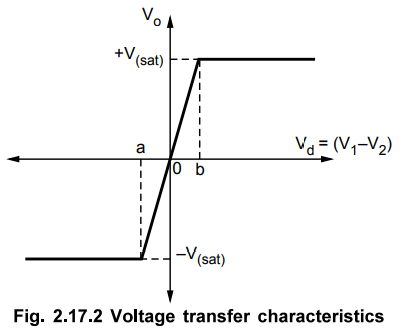Linear Integrated Circuits: Unit II: Characteristics of Op-amp
Open and Closed Loop Configuration of Op-amp
We know that the d.c. supply voltages applied to the op-amp are VCC and -VEE and the output varies linearity only between VCC and - VEE Since gain is very large in open loop condition, the output voltage Vo is either at its positive saturation voltage (+ Vsat) or negative saturation voltage (- Vsat) as V1 > V2 or V2 > V1 respectively.
Open Loop Configuration of Op-amp
The simplest possible way to use an op-amp is in the open loop mode. The Fig. 2.17.1 shows an op-amp in the open loop condition.

We know that the d.c. supply voltages applied to the op-amp are VCC and -VEE and the output varies linearity only between VCC and - VEE
Since gain is very large in open loop condition, the output voltage Vo is either at its positive saturation voltage (+ Vsat) or negative saturation voltage (- Vsat) as V1 > V2 or V2 > V1 respectively. This is shown in the Fig. 2.17.2.

Thus very small noise voltage present at the input also gets amplified due to its high open loop gain and op-amp gets saturated.
It can be seen from the Fig. 2.17.2, only for small range of input signal (from point a to b), it behaves linearity. This range is very small and practically due to high open loop gain, op-amp either shows + Vsat or - Vsat level.
This indicates the inability of op-amp to work as a linear small signal amplifier in the open loop mode.
Hence, the op-amp is generally not used in the open loop configuration.
Key Point Such an open loop behaviour of the op-amp finds some rare applications like voltage comparator, zero crossing detector etc.
Review Question
1. Explain why open loop configuration is not used in linear applications.
Closed Loop Configuration of Op-amp
The
utility of op-amp increases considerably if it is used in a closed loop mode.
The closed loop mode is possible using feedback. The feedback allows to feed
some part of the output back to the input. In linear applications the op-amp is
always used with negative feedback. The feedback helps to into saturation.
The
negative feedback is possible by adding a resistor as shown in the Fig. 2.18.1,
called feedback resistor. The feedback is said to be negative as the feedback
resistor connects the output to the inverting input terminal.

The
gain resulting with feedback is called closed loop gain of the op-amp. Due to
feedback resistance there is reduction in the gain. The closed loop gain is
much less than the open loop gain and is independent of it.
Most
of the linear circuits use op-amp in a closed loop mode with negative feedback
with Rf. This is because, due to reduced gain, the output is not driven into
the saturation and the circuit behaves in a linear manner.
The
advantages of negative feedback are,
i)
It reduces the gain and makes it controllable.
ii)
It reduces the possibility of distortion.
iii)
It increases the bandwidth i.e. frequency range.
iv)
It increases the input resistance of the op-amp.
v)
It decreases the output resistance of the op-amp.
vi)
It reduces the effects of temperature, power supply on the gain of the circuit.
Review Question
1. State the advantages of negative feedback.
Linear Integrated Circuits: Unit II: Characteristics of Op-amp : Tag: : - Open and Closed Loop Configuration of Op-amp
Related Topics
Related Subjects
Linear Integrated Circuits
EE3402 Lic Operational Amplifiers 4th Semester EEE Dept | 2021 Regulation | 4th Semester EEE Dept 2021 Regulation
